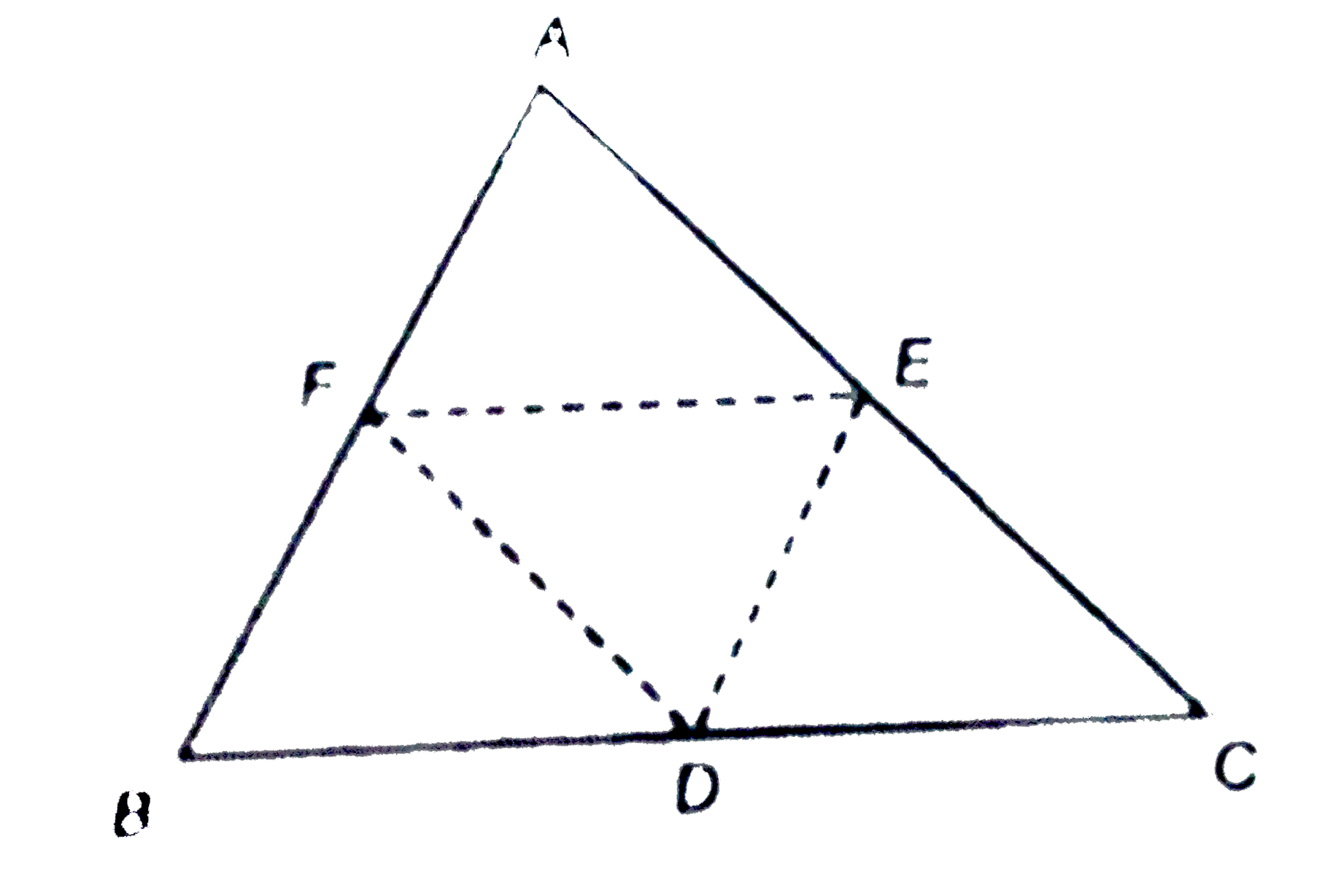P,Q,R are the points on the sides AB, BC and CA respectively of triangle ABC such that AP:PB=BQ:QC=AR:RC=1:2. Show that PBQR is a parallelogram.
To show that PBQR is a parallelogram, we will use the properties of vectors and the given ratios.
Step 1: Define the points using vectors
Let the position vectors of points A, B, and C be denoted as A, B, and C respectively. We can express the points P, Q, and R on the sides of the triangle as follows:
- Point P divides AB in the ratio 1:2, so we can write:
→P=2→A+1→B1+2=2→A+→B3
- Point Q divides BC in the ratio 1:2, so we can write:
→Q=2→B+1→C1+2=2→B+→C3
- Point R divides CA in the ratio 1:2, so we can write:
→R=2→C+1→A1+2=2→C+→A3
Step 2: Find vectors PB and QR
Next, we need to find the vectors PB and QR.
- The vector PB is given by:
→PB=→B−→P=→B−2→A+→B3=3→B−(2→A+→B)3=3→B−2→A−→B3=2→B−2→A3=2(→B−→A)3
- The vector QR is given by:
→QR=→R−→Q=(2→C+→A3)−(2→B+→C3)=(2→C+→A)−(2→B+→C)3=2→C+→A−2→B−→C3=→A+→C−2→B3
Step 3: Show that PB is parallel to QR
To show that PBQR is a parallelogram, we need to show that PB is parallel to QR.
From the expressions derived:
- We have →PB=2(→B−→A)3
- We need to check if →QR can be expressed in terms of →PB.
Notice that:
→QR=13(→A+→C−2→B)=13(→A−→B)+13(→C−2→B)
This indicates that QR can be expressed in terms of the vectors from A to B and B to C.
Step 4: Conclude that PBQR is a parallelogram
Since both PB and QR are proportional and parallel, we conclude that PBQR is a parallelogram.
Let the position vectors of points A, B, and C be denoted as A, B, and C respectively. We can express the points P, Q, and R on the sides of the triangle as follows:
→P=2→A+1→B1+2=2→A+→B3
→Q=2→B+1→C1+2=2→B+→C3
→R=2→C+1→A1+2=2→C+→A3
Next, we need to find the vectors PB and QR.
→PB=→B−→P=→B−2→A+→B3=3→B−(2→A+→B)3=3→B−2→A−→B3=2→B−2→A3=2(→B−→A)3
→QR=→R−→Q=(2→C+→A3)−(2→B+→C3)=(2→C+→A)−(2→B+→C)3=2→C+→A−2→B−→C3=→A+→C−2→B3
To show that PBQR is a parallelogram, we need to show that PB is parallel to QR.
- We have →PB=2(→B−→A)3
- We need to check if →QR can be expressed in terms of →PB.
→QR=13(→A+→C−2→B)=13(→A−→B)+13(→C−2→B)
This indicates that QR can be expressed in terms of the vectors from A to B and B to C.
Since both PB and QR are proportional and parallel, we conclude that PBQR is a parallelogram.
Similar Questions
D, E and F are the mid-points of the sides BC, CA and AB respectively of triangle ABC. Prove that:
BDEF is a parallelogram.
View SolutionIn triangle ABC, angle B is obtuse. D and E are mid-points of sides AB and BC respectively and F is a point on side AC such that EF is parallel to AB. Show that BEFD is a parallelogram.
View SolutionP and Q are points on the sides AB and AC respectively of a △ABC. If AP= 2cm, PB = 4cm AQ= 3cm and QC= 6cm. Show that BC= 3PQ.
View SolutionD, E and F are the mid-points of the sides BC, CA and AB respectively of triangle ABC. Prove that:
area of BDEF is half the area of ΔABC.
View SolutionIn the adjoining figure D, E and F are the mid-points of the sides BC, CA and AB respectively of ΔABC. Prove that:
(i) □BDEF is a parallelogram
(ii) area of ΔDEF=14× area of ΔABC
(iii) □BDEF=12× area of ΔABC

View SolutionD, E and F are the mid-points of the sides BC, CA and AB, respectively of an equilateral ΔABC. Show that ΔDEF is also an equilateral triangle.
View SolutionABCD is a parallelogram. Two points P and Q are taken on sides AD and BC respectively such that AP 13ADandCQ=13BC. Prove that □AQCP is a parallelogram.
View SolutionABCD is a square. P, Q and Rare the points on AB, BC and CD respectively, such that AP = BQ = CR. Prove that:
PB = QC
View SolutionABCD is a square. P, Q and Rare the points on AB, BC and CD respectively, such that AP = BQ = CR. Prove that:
PQ = QR
View SolutionD, E and F are the mid-points of the sides AB, BC and CA of an isosceles triangle ABC in which AB = BC. Prove that ΔDEF is also isosceles.
View Solution